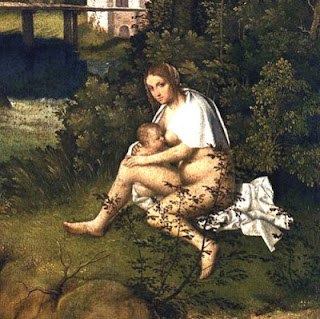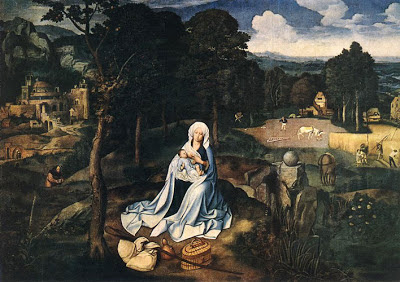Commentators have always regarded Giorgione’s Castelfranco Altarpiece as a unique and original work of art. It is Giorgione’s only known altarpiece, and although he used a traditional subject, he characteristically brought it to a new level.
 |
| Giorgione: Castelfranco Altarpiece Oil on panel, c. 1504 200.5 cm x 144.5 cm Castelfranco Veneto |
In a 2009 study of Giorgione, written in conjunction with the exhibition in Giorgione’s home town of Castelfranco Veneto that commemorated the five hundredth anniversary of the painter’s death, Enrico Maria dal Pozzolo wrote:
it would be unjust to diminish the importance of the very personal reworking that this young talent dared to express when he found himself standing before the great blank spaces of the panel,…[His] lifting the Madonna up to the highest possible height…but at the same time using that ‘emblematic” green cloth to tie them together and taking the back out of the chapel so that a preponderant landscape element might be added…is indicative of an approach that was totally original and free of conditioning. *
The story of the altarpiece was told best by Salvatore Settis in an extremely well researched essay that appeared in the catalog for the 2004 Giorgione exhibition, jointly sponsored by the Accademia in Venice and the Kunsthistorisches Museum in Vienna. For obvious reasons the Altarpiece was not included in the exhibition, but the essay by Settis was one of the highlights of the catalog.
I have reviewed the Settis article previously and would just note here that Settis argued that the donor’s connection to Sicily helped to establish the identity of the armored saint. It’s neither St. George nor St. Liberalis, the patron saint of the Cathedral, but St. Nicasius, a popular Sicilian saint holding the banner of the Order of Jerusalem.
In this case, the only candidate is St. Nicasius, venerated in Palermo and Messina, where his cult is associated with that of St. Francis (exactly as in the Altarpiece).**
In his essay Settis reproduced a journalist’s description of the painting from 1803 that I copy here as a model for seeing and understanding.
“Above a floor covered in square tiles of marble of different colours rises a Sarcophagus of Porphyry, on which is painted the coat of arms of the noble family Costanzo. Tuzio, famous warrior, disconsolate because of the death of his son, having ordered the erection of the Altar, it appears that the painter has delicately tried to alleviate his pain, placing behind the Tomb in an elevated position, a throne of whitish marble, on which sits Our Lady, on her knees her small Divine Child, with his head turned to observe the Sarcophagus itself. Behind the Virgin and supporting her on one side is a piece of inlaid marble. The entire base of the Throne is covered by a most beautiful tapestry, which hangs down a little…so far as to cover the sarcophagus, emerging from beneath the folds of the rich crimson robe…Behind the Sarcophagus and at the height of the Throne the picture is framed by a most beautiful crimson velvet, descending to the floor, which gives a pyramidal layout and artificially divides the upper part of the foreground of the painting. On the right…stands St. George…Of his feet, the right rests on the floor, the left on a small step leading up to the Sarcophagus,…St. Francis stands with both feet on the lowest level of the floor…” ***
My wife and I saw the Altarpiece in the spring of 2010. We had attended the annual meeting of the Renaissance Society of America that had been held that year in Venice, and decided to take the train to Castelfranco to see if we could get into the Giorgione exhibition. That Sunday was the closing day and the exhibition was sold out but we were able to see the Altarpiece on display in the Cathedral next door.
The first thing I noticed was the relatively small size of this extraordinarily beautiful painting that had been so carefully cleaned and restored in Venice only a few years before. It would certainly be dwarfed by Giovanni Bellini’s famed Venetian altarpiece in the church of S. Zaccaria that was completed in 1505. The small size of the “Castelfranco Altarpiece” stems from the fact that it was meant not for the high altar in a Cathedral but for a small funerary chapel.
I would just like to add an observation that has been inspired by Settis’ study. Above the sarcophagus there is a white marble altar on which the Madonna’s throne rests. But Franciscan spirituality regarded the Madonna herself as an altar on which her Son, the Eucharist, is placed. For confirmation we need only look at the white cloth underneath the Infant that also covers Mary’s head. It is the corporale that always covers an altar. Giorgione would later use the corporalein his famous “Tempest” where it winds around Mother and Child in much the same way.
But why two altars? On occasion a funerary chapel is opened for Mass. At the height of the Mass, immediately after the consecration, the priest utters an ancient formula: “Lord, let your angel take this sacrifice to your Altar in Heaven.” At every Mass the sacrifice offered at the earthly altar would be merged with the eternal sacrifice of the Heavenly Altar. In Giorgione’s painting we see the Heavenly Altar (Mary) right on top of the earthly altar.
This concept, that seems so strange to viewers today, is reinforced by Giorgione’s artistic genius. Where is the viewer in this painting? We are not at floor level with the saints. We seem to look down on them. How is it possible for us to see the landscape in the background behind the curtain? The landscape in which we live is in the background. The figures in the foreground are in another world.
###
*Enrico Maria dal Pozzolo: Giorgione, Milan, 2009, 167.
**Salvatore Settis: “Giorgione in Sicily–On the Dating and Composition of the Castelfranco Altarpiece.” In Ferino-Pagden, Sylvia, and Nepi-Scire, Giovanna: exh. Cat. Giorgione, Myth and Enigma, Vienna, 2004, 144.
***Settis, 135.

















































































